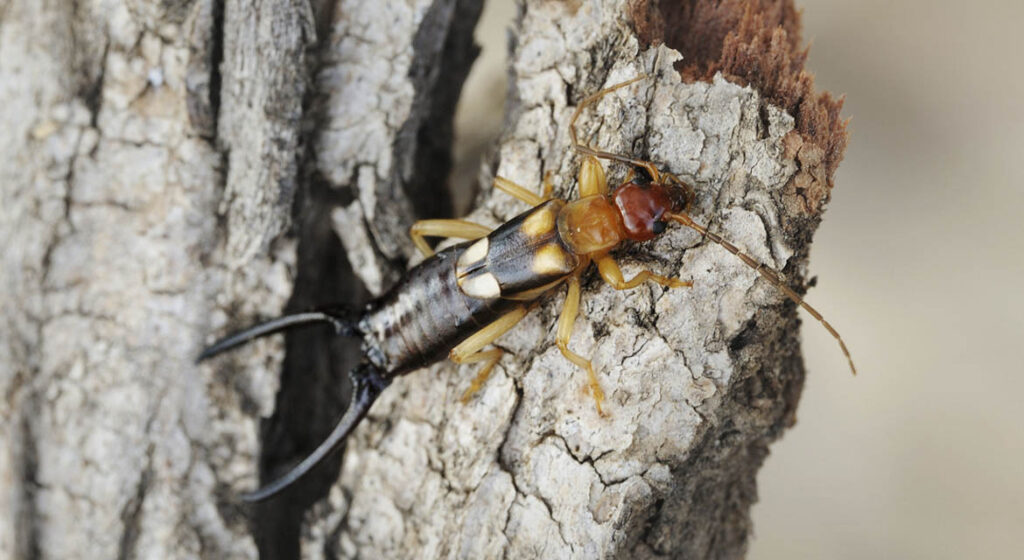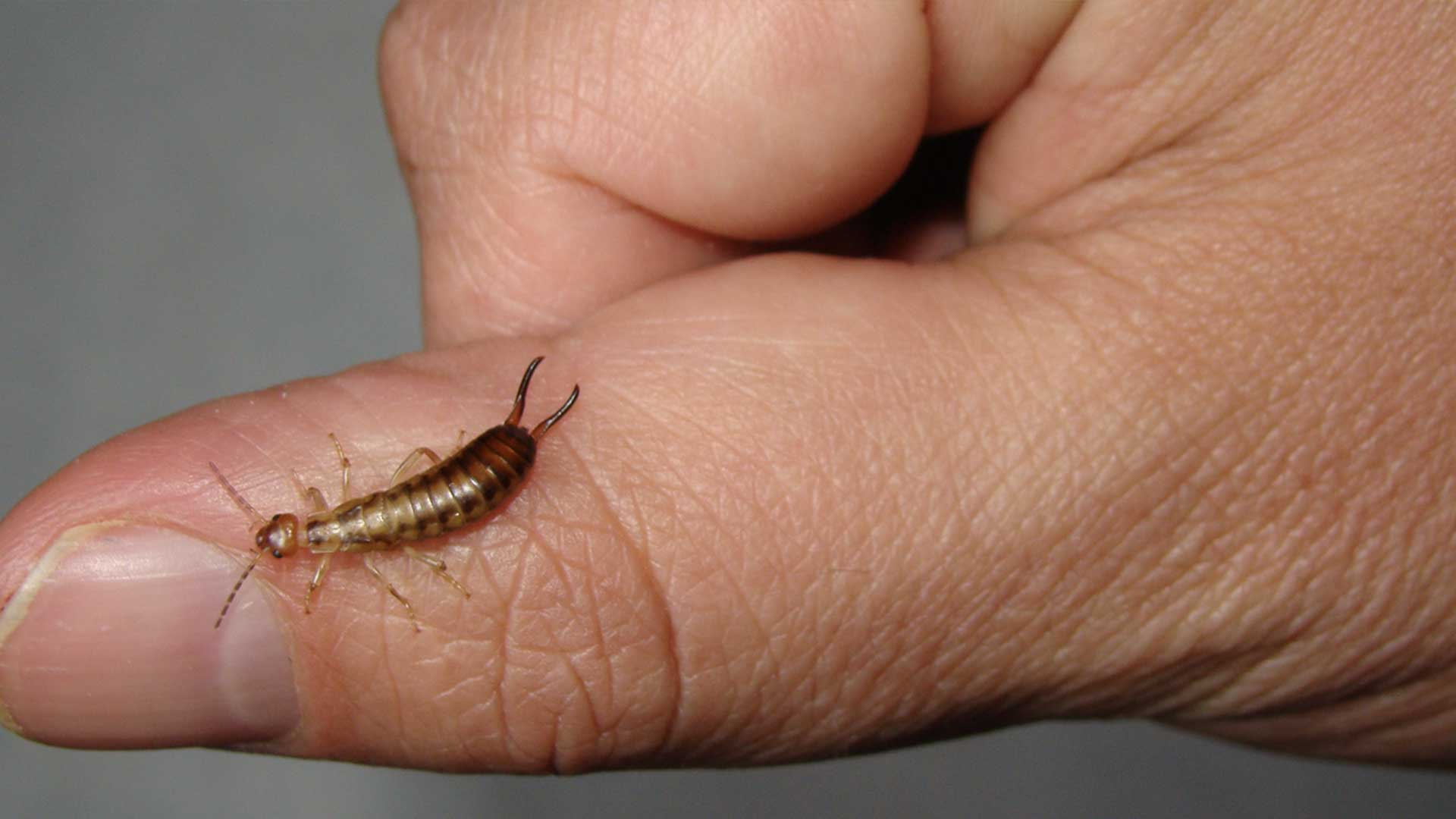
Are Earwigs Harmful or Dangerous to Humans?
People often consider earwigs a nuisance bug and give them a bad reputation due to their menacing appearance – most notably, their pincers – and the foul smell they emit when threatened. However, not all earwig species have pincers, and even those that do are not likely to use them in a harmful way toward humans. Here are three key points regarding the danger to humans:
- While earwigs have pincers, they rarely cause harm to humans and their pinch is not typically strong enough to cause significant damage.
- Earwigs may become a nuisance indoors but do not transmit diseases to humans.
- Earwigs pose minimal health risks to humans, as they are not venomous and cases of them entering human ears are rare and easily resolved by a medical professional.
The Not-So-Aggressive Bug With Formidable Pincers
Earwigs belong to the family Forficulidae and are found commonly in moist environments such as under rocks, leaf piles, and inside crevices. Some of the most common earwig species include the European and common earwig.
The earwig feeds on organic debris and living plants or crops. Earwigs are nocturnal bugs that come out at night to feed and reproduce.
If earwigs infest your home, they can become a nuisance making themselves at home in leaf piles, garbage, and outdoor lights. However, you should note that there are also beneficial aspects to earwigs. Earwigs can help control other pests, such as aphids, caterpillars, and spiders, and can be a food source for some animals, including lizards and birds.
If you encounter these insects in your home, they most likely got there by someone unintentionally letting them inside. Earwigs do not care to live indoors.
You can prevent earwigs from entering your home by sealing cracks and crevices, removing dead leaves, and reducing outdoor lights.
Are Earwigs Harmful or Dangerous to Humans?
Contrary to popular belief, earwigs do not pose a threat to humans. They are not known to transmit diseases, nor do they cause structural damage to homes. Furthermore, they only bite humans if provoked or threatened, and bites are rarely painful. Nevertheless, people continue to fear this pincered bug.
For people with insect bite allergies, earwig bites can cause anaphylactic reactions, and victims should seek medical attention immediately.

Truly Nolen GUARANTEE
If you’re not completely satisfied, you’ll get a full refund on your most recent service with our 100% money back guarantee.

$50 Off Year Round Pest Control
Truly Nolen is a family-owned company with 85 years of experience providing the best pest control. If you’re not completely satisfied, you’ll get a full refund on your most recent service with our 100% money back guarantee.
Can Earwigs Infect the Human Ear Canal?
The fear of earwigs stems from urban legends rather than any actual threat. There is a myth that earwigs crawl into the human ear canal and cause damage, but this is untrue. The likelihood of an earwig entering the human ear canal is quite slim. These insects are not attracted to the human ear and cannot crawl into it unnoticed.
Though an earwig can crawl onto a human ear, it is unlikely that it would choose to enter the ear canal, which is a small, cramped space with little food or shelter. Even if an earwig accidentally crawled into the ear, it would quickly become disoriented and try to escape.
If an earwig managed to enter the ear canal, it would likely cause discomfort and pressure in the affected ear. In some cases, it could even cause temporary hearing loss. However, these symptoms are not life-threatening and can be quickly resolved by flushing the ear with warm water or seeking medical attention.
While it is true that earwigs are attracted to moist environments, these bugs do not target the human ear canal. Instead of the ear, earwigs are more likely to hide in leaf piles, organic debris, and other moist areas around the home exterior.
Do Earwigs Bite?
One of the biggest questions surrounding earwigs is whether or not they are capable of biting humans.
The truth is that while earwigs do have pincers, they are not powerful enough to inflict painful bites on humans. In fact, earwigs are generally considered harmless to humans and are more of a nuisance pest than a dangerous one.
While earwigs may not bite humans, they can still cause damage to plants and crops, making them a common garden pest.
In conclusion, while they may release a foul-smelling liquid when threatened, the earwigs pincers are not strong enough to cause a painful bite. If you experience skin irritation or allergic reactions after touching this bug or its secretions, seek medical attention immediately to prevent potential complications.
Are There Any Health Risks Associated With Earwigs?
One of the most common health risks from earwigs is their potential to bite when threatened or startled. The resulting bites are not dangerous and are more uncomfortable than painful, but they can lead to swelling and reddening of the skin. Bites look like red raised welts and rarely, if ever, break the skin. If you notice broken skin or worry about the possibility of wound infection, it is best to apply an antibiotic/antibacterial cream to the area.
Another health risk associated with earwig infestations is their foul smell. When threatened, these pests release a distinct odor that can be unpleasant. The scent that the earwig releases is resembles a combination of feces and decay – no wonder predators are scared away by this scent! For example, if a lizard were to try to eat the earwig, it would release this awful-smelling liquid from its mouth and force the lizard to spit them out. The odor of this secretion can also be problematic to humans as it can linger on clothing, bedding, and furniture and be hard to eliminate.
There is also concern that earwigs can carry bacteria that can cause human infection. While there is no definitive evidence that earwigs are carriers of harmful bacteria, they could transfer bacteria from the organic debris or dead leaves they come in contact with.
If you get bitten by one of these insects, clean the affected area with antibacterial cream and watch for any signs of infection.
It is also important to note that earwig pincers do not release any venom, so if an earwig does bite a human, there is little chance of hives or an allergic reaction. The only exception to this rule is for people who are hyper-sensitive to insect bites; these people may experience an allergic reaction if bitten. If an allergic reaction is not significant enough to cause anaphylaxis, it can cause multiple small, closely clustered red welts, or larger red welts spaced further apart on the skin.
This pincered insect is not a dangerous bug for humans to encounter. While they can be annoying garden pests, they do not threaten our health and safety. So the next time you see an earwig scurrying around, try not to be too afraid. It is just another harmless creature looking for its next meal.

$50 Off Year Round Pest Control
Truly Nolen is a family-owned company with 85 years of experience providing the best pest control. If you’re not completely satisfied, you’ll get a full refund on your most recent service with our 100% money back guarantee.
Is It Necessary To Call a Professional Pest Control Expert For Earwigs?
When facing earwigs in your home or business, you may want to call pest professionals thinking that you have an infestation. However, it is unlikely that earwigs will infest the interior of your home in large numbers, and in most cases, a professional pest control expert is unnecessary.
Calling pest control experts like Truly Nolen pest control experts may be necessary, however, if earwigs in your home pose a risk to the health and safety of you and your family due to allergies or sensitivities. In this incidence, a pest control expert can implement safe and effective methods to rid your home or business of these harmful pests. These pest specialists will inspect your home and determine the best course of treatment, which may include using insecticides, baits, or traps.
If you are concerned about these pests but do not want to expose your plants; family; pets; or environment to toxic chemicals, there are non-toxic treatment approaches to controlling earwig problems. The most common non-toxic removal methods include diatomaceous earth, boric acid, or installing window screens in your home. If you prefer using these non-chemical treatment methods, tell your pest control specialist company before they come to your property.
You may also want to call professional pest control experts if you have a large number of earwigs around the exterior of your home. While they prefer to live outdoors, they can still be troublesome when you have many of them in your garden!
Earwigs damage a lot of garden life including
- Flowers
- Fruit
- Seedlings
- Roots
- Leaves
Earwigs most frequently target food-based plants and trees like tomatoes, cauliflower, beans, peas, corn, and apples – but they also target ornamental plants. This destruction can be particularly troublesome if you are a gardener or homesteader who depends on their garden for food.
In addition to spotting earwigs in your garden, you can also look for other signs of their presence, which include:
- Flowers that have holes in them
- Fruit chewed through
- Leaves with holes in them
- Damaged seedlings
- Rough edges around leaves
- Flowers chewed around the edges
- Seedlings that are completely eaten
Of course, many critters in your garden could be to blame for this activity, but remember that earwigs tend only to target fruits and plants that are soft enough to chew through.
If you are unsure what has been chewing through your plants and flowers, you can look around for earwigs. Since these are nocturnal bugs, it is unlikely that you will catch them in the act of destroying your plants, but you can stir them up out of their hiding places during the day.
Most often, you can find these insects hiding just under the soil surface in plant beds, under composting materials and grass clippings, and hiding in other plant material during the daytime. Simply lifting these materials or disturbing the soil will send the earwigs running or make them burrow down through the soil to get away.
Earwigs become particularly problematic during spring months, as the weather begins to warm up. In May, the female earwig will lay its eggs and increase the insect population.
No matter what time of year you notice a problem with earwigs in or around your home, don’t be afraid to call in a pest control company. Whether you see one or one hundred of these insects, a pest control company can help you to secure your home and garden from these bugs.
How Do I Get Rid of Earwigs?
If you find earwigs (or any bug) to be a problem in your garden and outside your home, these tips can help you to get rid of them –
1. Eliminate Moisture: These insects prefer moist environments, so eliminating moisture is the first step in eliminating them. Ensure you have no leaky pipes or standing water in or around your home. Remove any sources of moisture in your garden, such as wet leaves or rotting wood.
2. Reduce Clutter: Earwigs love to hide, so reducing clutter can make your home and garden less attractive to them. Remove dead leaf piles, grass clippings, and other organic debris from your garden – this is particularly important in spring when the weather warms up and you start mowing your lawn. Inside your home, declutter your basement, garage, and attic.
3. Use Diatomaceous Earth: Diatomaceous earth is a natural substance that can eliminate earwigs. This powdery substance is abrasive and dries out the earwigs, effectively killing them. Sprinkle diatomaceous earth around the base of your home or garden plants to create a barrier that keeps earwigs out.
4. Apply Insecticides: Insecticides are another effective way to eliminate earwigs. Look for insecticides specifically designed for earwig control. Apply the insecticide in the areas where earwigs are most commonly found, such as near your home foundation or in the garden. If you plan to apply any insecticide around your house, leave the job to pest control professionals like Truly Nolen pest control experts, who can ensure to target the entire population of insects.
5. Seal Entry Points: Earwigs can enter your home through small cracks and crevices. Seal any entry points to your home with caulk or foam sealant. Ensure that your window screens fit tightly and that doors have weather stripping.

$50 Off Year Round Pest Control
Truly Nolen is a family-owned company with 85 years of experience providing the best pest control. If you’re not completely satisfied, you’ll get a full refund on your most recent service with our 100% money back guarantee.
Frequently Asked Questions
Are earwigs harmful or dangerous to humans?
Earwigs are generally not harmful or dangerous to humans. While they possess pincers, they are primarily used for defense and rarely bite humans. However, in rare cases, they may pinch if they feel threatened, causing a minor irritation. Learn more about earwigs
How do earwigs enter homes?
Earwigs can enter homes through small cracks and openings, such as gaps in doors, windows, or foundation walls. They are attracted to moisture and can be found in damp areas like basements, bathrooms, and kitchens. They may also hitch a ride on plants or outdoor items brought indoors.
What are the signs of an earwig infestation?
Signs of an earwig infestation include the presence of live or dead earwigs, especially in areas with moisture or hiding spots like basements, bathrooms, or kitchens. Damage to plants, fruits, or vegetables can also indicate their presence. Learn More!
How can I prevent earwigs from infesting my home?
To prevent earwig infestations, you can take the following steps: seal any cracks or openings in doors, windows, and foundation walls, reduce moisture levels in and around your home by fixing leaks or improving drainage, remove debris and organic matter near the foundation, and keep outdoor lights off or use yellow bulbs, as bright lights attract earwigs.
Can I get rid of earwigs on my own, or do I need professional help?
While some DIY methods like reducing moisture and eliminating hiding spots may help control earwig populations, severe infestations often require professional pest control assistance. Pest control experts can provide targeted treatments, assess the extent of the infestation, and offer ongoing monitoring to effectively eliminate earwigs from your home.

